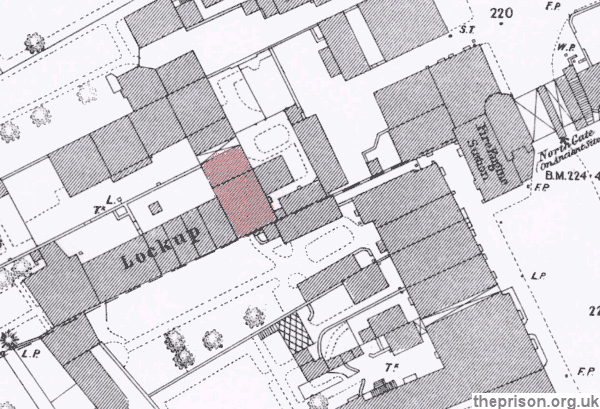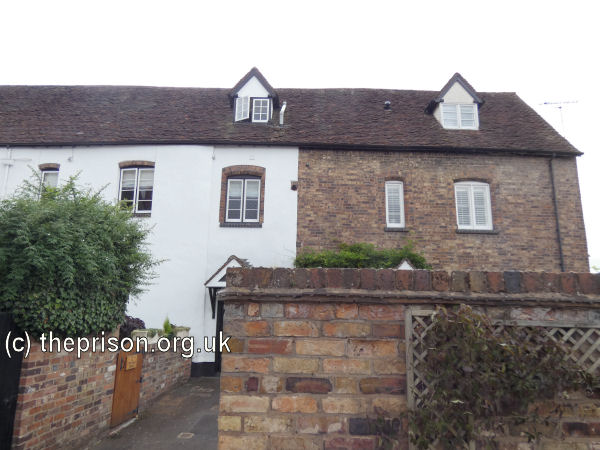Borough Gaol and Lock-up House, Bridgnorth, Shropshire
The Bridgnorth had a Borough Gaol by 1268, when John de Ercalew was appointed to try the cases of those held there.
The gaol's location appears to be uncertain prior to 1823 when a new building was erected at 5 Whitburn Street, Bridgnorth, at the west side of the town's North Gate. By 1830, however, it was said to be only being used for temporary confinement, with the local magistrates having the power of committing offenders to the county gaol at Shrewsbury.
In 1837, the Inspectors of Prisons reported:
THIS Prison is in the rear of the Workhouse, there being but one entrance to both Establishments.
On the ground floor are two Cells 17 feet by 8 feet, and 8 feet high; they have each a Window 14 inches by 12; they are dark, cold, and damp. The partition walls of the Cells are 20 inches, and of brick. There is in each of the Cells a privy. There is also a wooden bedstead 6 feet 6 inches by 5 feet 6 inches.
Adjoining the Cells is an Apartment 17 feet 6 inches by 11 feet 4 inches, and 9 feet high. The floor is of brick.
On an upper floor is a room for Debtors, 17 feet 6 inches by 11 feet, and 7½ feet in height. The Window is 3 feet 6 inches by 2 feet 6 inches.
Adjoining is a Bed-room 12 feet by 8 feet, and 7½ feet high.
Another Room on the same floor is 16 feet 6 inches by 8 feet 6 inches, and 7½ feet high. The Windows of these Apartments are 2 feet by 18 inches.
We found but one Prisoner in confinement, a Deserter. He was confined to his bed with a disorder which the Surgeon said bordered on typhus. The Surgeon complained that there is no adequate accommodation for the Sick.
All Prisoners sentenced to hard labour are committed to the County Gaol at Shrewsbury. Debtors, who take the benefit of the Act, are also sent thither.
The total number of Commitments in 1836 was 22; and the greatest number in confinement at one time was three.
As the distance from Bridgnorth to Shrewsbury is 14 miles, and as there are great facilities for enlarging the present Prison, we conceive that it will be advantageous for the Borough to reconstruct the present Gaol for the separate confinement of as many Prisoners as are likely to be at one time in custody. The magistrates are ready to conform to any arrangement for this purpose.
Following alterations and additions, the gaol was separated off from the workhouse, as noted in the Inspectors' report in 1840:
Construction.—There is a new building here for females, which has been erected since my last visit, and at my suggestion. It contains 1 yard, 3 rooms, and a privy.
There are also 2 cells appropriated for breaking stones, in the yard for prisoners sentenced to hard labour. They are large and convenient, and the prisoners are locked in to work separately.
The prison is now quite unconnected with the workhouse, and has a separate entrance of its own, in a quiet, unobserved, and secluded part of the town.
Management.—This whole establishment is greatly improved since my last visit.
A new Keeper was appointed 1st November, 1838. The former keeper resigned; he was a saddler, who could not be absent from his business. The present one is a pensioner of Greenwich. He receives no salary; but has 6d. a-day for each prisoner, and 6d. besides for each prisoners maintenance. He feeds them as nearly as possible, he says, according to the dietary given him by the clerk of the peace, which is as follows:—
Men, l½b. bread daily.I found that all had had meat for dinner on the day of my visit.
Women, 1 lb. bread daily ; boys, 1 lb. bread daily.
Half a pint of gruel daily at breakfast.
Do. at supper.
Dinner on Sundays, ½oz. butter.
Mondays, Wednesdays, Fridays, 1¼ boiled potatoes.
Tuesdays, Thursdays, Saturdays, ½ pint of soup.
The keeper’s wife cooks.
There is no salaried matron, but the keeper’s wife attends to the female prisoners. The keeper is allowed coals and candles, and charges for soap. He had MS. rules given him on entering office.
On the night preceding my visit, two men had slept together, but this seems to occur rarely.
No combs are provided.
There has been no occasion for punishment since the keeper has been here. The prisoners are very orderly.
This prison is neat, clean, and in good condition, and wears a better aspect than most borough gaols. The keeper appears attentive, and anxious to do well. The terms of imprisonment are mostly short. The prisoners are allowed to associate. Silence it is impossible to enforce with only one officer. All letters are read by the keeper. Visits are only allowed by order of a magistrate, and the keeper is always present.
Solitary confinement has never been ordered since the keeper has been here.
It would be better if the keeper had a fixed salary in lieu of the 6d. a-day per head, and the. other 6d. per head for diet; but he seems to do the best that can be expected under the circumstances.
Escape.—One prisoner escaped in May, 1839, but was re-taken. He had been put in for breaking a window, value 3s. 6d. Repairs were going on at the time in the prison.
Suicide.—About a-year ago a man attempted to cut his throat with a glass, but did not succeed.
Treatment of the Sick, Disease and Mortality.—There has been no death since my visit in 1837. No patient has been confined to his bed since the keeper has been here. I found one man suffering under lumbago, who had had pills and liniment from the surgeon.
The surgeon only comes when sent for. He is appointed by the mayor. If the surgeon orders extra food, the gaoler is paid for it. No one of the four prisoners whom I found here, except the above man, had been ill since admission.
There is one wooden moveable bath.
Religious and other Instruction.—There is no chapel or chaplain. About five months ago the clergyman of the parish came twice to see a young man. There is a supply of Bibles and prayer-books. Diet.—(See Management.)
Population.—One hundred and twenty-five prisoners were received here from October 12, 1838, to September 17, 1839. The previous accounts are not regularly kept.
This number includes all the night-charges, all the cases of drunkenness, &c., because all disorderly or drunken persons taken up by the police are brought hither. The prisoners, at the date of my visit, September 17, 1839, were—
2 Men (1 married, 1 single : 1 could read, the other not.)
2 Women (1 widow, 1 single : 1 could not read, the other could.)
4 Total.
One of the men was charged with trespassing in search of game; the other for taking some straw. Both women had been committed for robbery.
Greatest number of prisoners at once since the present keeper has been here, 8—of whom about 5 were for drunkenness.
Debtors may be received here, but there have been none during the present keepers time.
So many as half the prisoners are vagrants; the rest are townspeople.
During three weeks lately there was not 1 prisoner, but generally there have been 2 or 3 at once.
Stock.—There are eight sets of bedding; five suits of clothes for the men, but none for the women.
Suggestions towards Improvement.
The principal defect here at present is the want of a chaplain; and, indeed, of every kind of religious instruction. The mayor informs me that some time ago two clergymen of the Church of England, resident in the town, agreed to execute the office of chaplain; but it appears, notwithstanding, that Divine service has not been since performed, and that the visits of any clergyman have been extremely rare. I am inclined to believe, then, that if these gentlemen did really undertake the office, they did not interpret their acceptance of it as imposing any duty more arduous than an occasional visit. Nor, indeed, is it to be expected that such an office can be adequately sustained, unless by an individual regularly and distinctly engaged to fulfil certain regular duties, and to receive a fixed compensation in return. I have noticed above the allowance of money to the keeper for the maintenance of each prisoner, as a custom which it would be well to discontinue.
The prison site is shown on the 1884 map below. The main building is shaded red, with a row of lock-up cels to its rear,

Borough Gaol and Lock-up House site, Bridgnorth, c.1884.

Former Borough Gaol (white section) Bridgnorth, Shropshire, 2020. © Peter Higginbotham
In 1852, when the gaol was referred to as the Borough House of Correction and Borough and County Lock-up House, it as reported that the total number of inmates during the whole of 1851 had been five. The gaol appears to have closed in about 1854, though the lock-up house appeas to have continued to operate until at least the 1870s. The surviving part of the main building is now in residential use.
Records
Note: many repositories impose a closure period of up to 100 years for records identifying individuals. Before travelling a long distance, always check that the records you want to consult will be available.
-
Shropshire Archives, Castle Gates, Shrewsbury, Shropshire SY1 2AQ. Please note that records may contain gaps or have access restrictions - please check before visiting.
Fairly few records survive. Holdings include: an 1835 "Account of Subsistence of Prisoners in Bridgnorth Gaol" which records the prisoners, their crime, date of imprisonment and length of sentence. - The National Archives, Kew, Richmond, Surrey, TW9 4DU. Has a wide variety of crime and prison records going back to the 1770s, including calendars of prisoners, prison registers and criminal registers.
- Find My Past has digitized many of the National Archives' prison records, including prisoner-of-war records, plus a variety of local records including Manchester, York and Plymouth. More information.
- Prison-related records on
Ancestry UK
include Prison Commission Records, 1770-1951
, and local records from London, Swansea, Gloucesterhire and West Yorkshire. More information.
- The Genealogist also has a number of National Archives' prison records. More information.
Bibliography
- Higginbotham, Peter The Prison Cookbook: A History of the English Prison and its Food (2010, The History Press)
- Brodie, A. Behind Bars - The Hidden Architecture of England's Prisons (2000, English Heritage)
- Brodie, A., Croom, J. & Davies, J.O. English Prisons: An Architectural History (2002, English Heritage)
- Harding, C., Hines, B., Ireland, R., Rawlings, P. Imprisonment in England and Wales (1985, Croom Helm)
- McConville, Sean A History of English Prison Administration: Volume I 1750-1877 (1981, Routledge & Kegan Paul)
- Morris, N. and Rothman, D.G. (eds.) The Oxfod History of the Prison (1997, OUP)
- Pugh R.B. Imprisonment in Medieval England (1968, CUP)
Links
- Prison Oracle - resources those involved in present-day UK prisons.
- GOV.UK - UK Government's information on sentencing, probation and support for families.
Except where indicated, this page () © Peter Higginbotham. Contents may not be reproduced without permission.



